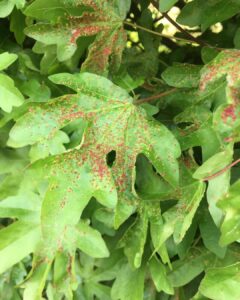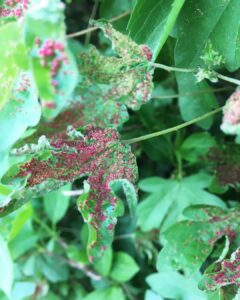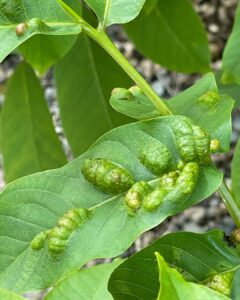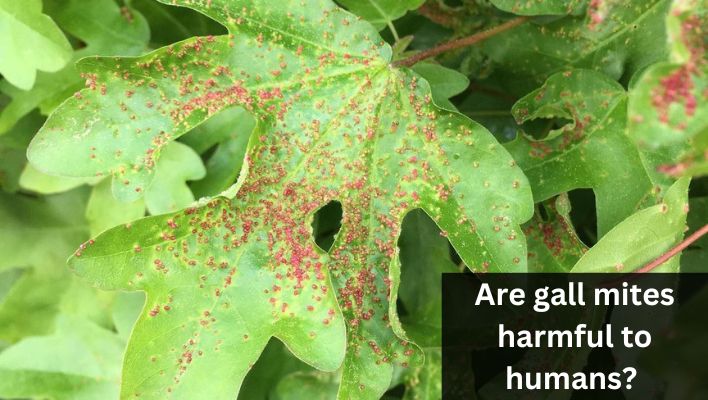Gall mites are tiny arachnids that play a fascinating role in the formation of plant galls. These minuscule creatures, often measuring less than a millimeter in size, belong to the arachnid family, which also includes spiders and ticks.
While they may seem insignificant, gall mites have a remarkable ability to induce peculiar growths on plants known as galls. Galls are abnormal plant structures that develop in response to gall mite activity.
When gall mites lay their eggs on leaves, stems, or buds of host plants, the plant reacts by producing specialized tissues around the mites. This protective structure, the gall, provides a sheltered environment where the mites can feed and complete their life cycle.
Gall mites and their interactions with plants are a captivating subject of study, but what about their impact on humans? In this article, we will explore the world of gall mites and delve into whether they pose any harm to us. Let’s unravel the mysteries of these tiny arachnids and their relationship with plant galls.
What Are Gall Mites?
Gall mites, those tiny arachnids that often fly under the radar, have a peculiar knack for causing the formation of abnormal growths known as galls on plants.
These minuscule creatures belong to the family Eriophyidae and share a close kinship with spiders and ticks. Let’s take a closer look at these intriguing organisms.
Physical Appearance:
Gall mites are truly the masters of disguise, measuring a mere fraction of a millimeter in size. They are so small that they often require magnification to be observed properly.
With their translucent or semi-transparent bodies, these arthropods can easily go unnoticed by the naked eye.
Under a microscope, you would notice their characteristic elongated shape and four pairs of legs, typical of arachnids.
These legs, though extremely tiny, are remarkably well-adapted for their intended purpose – maneuvering on the surface of plant tissues.

Life Cycle and Habitat:
To truly understand gall mites, we must delve into their life cycle and preferred habitat. These remarkable creatures start their journey as eggs, which are laid on various parts of host plants, such as leaves, stems, buds, or flowers.
The exact location of egg deposition depends on the specific species of gall mite and the host plant they inhabit. Once hatched, the young gall mites, known as larvae, emerge and commence their feeding frenzy.
They extract vital nutrients from the plant tissues, stimulating the plant to respond with an extraordinary defense mechanism – the formation of galls. The galls provide both a protective shelter and a source of sustenance for the developing mites.
As the gall mites grow, they undergo several molts, shedding their exoskeletons and progressing through different stages known as nymphs. These nymphs continue to feed within the galls until they reach maturity. Once fully developed, adult gall mites may remain within the galls or venture out to find new host plants for reproduction.
In terms of habitat, gall mites can be found in diverse environments, as they infest a wide range of plant species. From ornamental gardens to crops, these adaptable arachnids have managed to establish their presence in various ecosystems around the world.
Can Gall Mites Harm Humans?
One common misconception surrounding gall mites is whether they pose any harm to humans. It’s easy to understand why this question arises – after all, the idea of tiny arachnids causing deformities on plants might raise concerns about potential effects on our well-being.
However, it’s important to clarify the distinction between gall mites and the types of mites that can harm humans.
Gall mites are primarily plant feeders. They obtain their nutrition by extracting juices from the plant tissues within the galls they induce. Unlike blood-feeding mites, such as certain species of ticks or mites that infest animals, gall mites lack the adaptations necessary to bite or sting humans.
While gall mites may occasionally come into contact with our skin, it’s crucial to understand that they are not equipped to directly harm us. They lack the specialized mouthparts required to pierce our skin and draw blood, but they can affect plants’ growth.
So, rest assured, encountering gall mites in the garden or natural surroundings does not pose a direct threat to our health. However, it’s worth noting that some individuals may experience allergic reactions or skin irritations when in contact with gall mites or the galls they induce.
These reactions are typically mild and localized, resulting in symptoms like redness, itchiness, or a rash. If you suspect a skin irritation is caused by gall mites, it’s advisable to consult a healthcare professional for proper diagnosis and guidance.

How Do Gall Mites Interact with Humans
While gall mites primarily focus on their plant hosts, it’s natural to wonder about any potential interactions between these tiny arachnids and humans.
Although gall mites do not pose a direct threat to our health, it’s important to explore any possible allergic reactions or skin irritations that may arise from contact with these microscopic creatures.
When humans come into contact with gall mites or the galls they induce, some individuals may experience mild allergic reactions or skin irritations.
These reactions are generally localized to the area of contact and vary in intensity from person to person. Common symptoms include redness, itchiness, and the development of a rash.
It’s important to note that these allergic reactions and skin irritations are typically a result of individual sensitivities rather than inherent harm caused by the gall mites themselves.
Just as some people may be allergic to certain plants or substances, a similar allergic response can occur when encountering gall mites or their galls.
If you suspect that you have come into contact with gall mites and are experiencing skin irritation, it’s advisable to consult a healthcare professional for an accurate diagnosis and appropriate treatment.
They can help determine the underlying cause of the reaction and recommend the best course of action to alleviate any discomfort.
It’s worth emphasizing that the occurrence of allergic reactions or skin irritations related to gall mites is relatively rare.
The majority of people will not experience any adverse effects from incidental contact with these arachnids. Gall mites are primarily focused on their plant hosts and do not actively seek out or cause harm to humans.
Health risks associated with gall mites
When it comes to the potential health risks associated with gall mites, it’s important to understand that these tiny arachnids are primarily focused on their plant hosts and their interactions with humans are minimal.
Gall mites are not known to transmit diseases to humans, and there are no documented cases of specific health issues directly caused by gall mite exposure.
Gall mites have evolved to extract nutrients from plant tissues within the galls they induce, and their biology is not geared toward infecting or affecting humans. Unlike certain blood-feeding mites or ticks that can transmit diseases, gall mites lack the mechanisms and adaptations necessary for such transmission.

While there have been occasional reports of skin irritations or allergic reactions associated with gall mites, these instances are relatively rare. The majority of people will not experience any adverse health effects from incidental contact with gall mites or their galls.
It’s important to note that any allergic reactions or skin irritations that occur concerning gall mites are typically due to individual sensitivities or pre-existing allergies, rather than a direct consequence of the mites themselves. These reactions are generally mild and localized, causing symptoms like redness, itching, or a rash in the area of contact.
If you have concerns about potential health risks related to gall mite exposure or if you experience any unusual symptoms after contact with them, it’s recommended to consult a healthcare professional for proper diagnosis and guidance. They can help evaluate your specific situation and provide appropriate advice or treatment if needed.
Precautions and prevention
While gall mites pose minimal health risks to humans, it’s understandable that you may want to take precautions to minimize contact with these tiny arachnids. Here are some practical tips to help you avoid gall mite encounters:
- Wear protective clothing: When working or spending time in areas where gall mites may be present, consider wearing long sleeves, long pants, closed-toe shoes, and gloves. This can act as a barrier between your skin and any potential contact with gall mites or their galls.
- Be mindful of plant contact: Be cautious when handling or brushing against plants, especially if you notice the presence of galls. Avoid direct contact with galls or areas where gall mites are likely to reside, such as leaf undersides or damaged plant tissues.
- Regularly inspect plants: Routinely inspect your garden or indoor plants for any signs of galls or gall mite infestations. Early detection can help prevent the spread of gall mites and minimize their impact on the plants.
- Practice good gardening hygiene: Maintain a clean and well-maintained garden by removing any fallen leaves, pruning dead or infested plant parts, and properly disposing of them. This can help reduce the overall population of gall mites in the area.
- Consider natural predators: Encourage natural predators of gall mites, such as certain species of predatory mites, ladybugs, or lacewings, by creating a diverse and balanced ecosystem in your garden. These beneficial insects can help keep gall mite populations in check.
- Follow recommended gardening practices: Implement good gardening practices, such as proper irrigation, fertilization, and adequate plant spacing, to promote overall plant health. Healthy plants are more resilient and less prone to gall mite infestations.
- Seek professional advice: If you suspect a significant gall mite infestation or need assistance in managing their presence, consult with a professional pest control or horticulture expert. They can provide tailored guidance and recommend appropriate measures for reducing gall mite populations.
By following these precautions and prevention strategies, you can minimize the likelihood of gall mite contact and ensure a healthy environment for both your plants and yourself.
Remember, while gall mites may not pose significant harm to humans, it’s always beneficial to maintain good gardening practices and stay informed about potential risks.
Are Gall Mites Harmful to Humans FAQs
Can gall mites infest human bodies?
No, gall mites do not infest human bodies. They are primarily plant feeders and lack the adaptations necessary to invade and survive on human skin or in human bodies. Their interactions with humans are minimal and usually limited to incidental contact.
Can gall mites bite or sting humans?
No, gall mites cannot bite or sting humans. They lack the specialized mouthparts or stingers required for such actions. Gall mites are focused on extracting nutrients from plant tissues within the galls they induce and do not pose a direct threat to human health.

Do gall mites transmit diseases to humans?
No, there is no evidence to suggest that gall mites transmit diseases to humans. They are not known to be vectors for human diseases.
Gall mites have a specific biology that is adapted to plant feeding, and their interactions with humans are typically limited to incidental contact without disease transmission.
Are there any documented cases of health issues caused by gall mites?
There are no documented cases of specific health issues directly caused by gall mites. However, some individuals may experience mild allergic reactions or skin irritations when in contact with gall mites or their galls.
These reactions are typically localized and result from individual sensitivities or pre-existing allergies, rather than inherent harm caused by the gall mites themselves.
What should I do if I suspect an infestation?
If you suspect a gall mite infestation in your garden or indoor plants, it is advisable to take the following steps:
- Inspect the plants: Look for signs of galls, distorted growth, or other indications of gall mite presence.
- Confirm the infestation: If you suspect an infestation, consult with a horticulture expert, plant pathologist, or pest control professional to confirm the presence of gall mites and assess the extent of the infestation.
- Follow recommended control measures: Depending on the severity of the infestation, appropriate measures can be implemented, which may include cultural practices, biological controls, or targeted chemical treatments. A professional can provide specific recommendations tailored to your situation.
- Practice good gardening hygiene: Maintain a clean and well-maintained garden by removing infested plant parts, properly disposing of them, and implementing preventive measures to minimize future infestations.
Conclusion
Gall mites, those tiny arachnids known for inducing abnormal growths on plants called galls, are not harmful to humans. Throughout this article, we have explored the world of gall mites, their physical appearance, life cycle, and preferred habitat.
We have addressed common misconceptions and clarified that gall mites do not pose a direct threat to human health. Gall mites are primarily plant feeders and lack the adaptations necessary to infest human bodies, bite, or sting humans.
They do not transmit diseases to humans, and there are no documented cases of specific health issues caused by gall mites. Any skin irritations or allergic reactions that may occur are typically a result of individual sensitivities or pre-existing allergies.
To minimize contact with gall mites, precautions can be taken, such as wearing protective clothing and being mindful of plant contact.
Good gardening practices, regular inspection of plants, and creating a balanced ecosystem can help reduce gall mite populations. If you suspect a gall mite infestation, consulting a professional for accurate diagnosis and appropriate measures is recommended.
